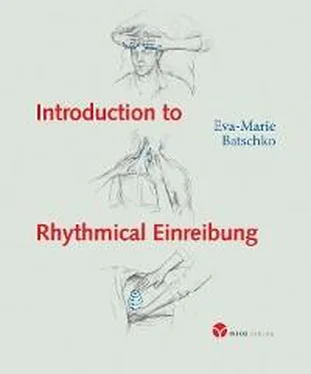Eva-Marie Batschko
Introduction to Rhythmical Einreibung
as developed by Wegman / Hauschka
Drawings by Nadja Holland
Translation by Jeff Martin and Prof. Dr. med. David Martin
Edited by Christian von Arnim

To my teacher Dr. Margarethe Hauschka 1896-1980
ISBN 978-3-924391-94-2
Publisher: Info3 Verlag, Frankfurt am Main, Germany
All rights reserved, © 2019 by Carus-Akademie, Hamburg
Original title in German: Eva-Marie Batschko: Einführung in die Rhythmischen Einreibungen, Stuttgart 2003 (Verlag Joh. M. Mayer), ISBN 978-3-932386-73-2
Table of contents
Introduction to Rhythmical Einreibung
Introduction Introduction This book was written at the suggestion of seminar participants from the Rhythmical Einreibung training at the Carus Academy in Hamburg. It is the result of more than 30 years of practical experience and intensive engagement with this treatment method. It is based on Rudolf Steiner's anthroposophical understanding of the human being. The book aims to give the reader a deeper insight into the living essence of this new technique by providing a detailed description of the individual treatment steps with numerous illustrations. Clearly the content of this introductory volume cannot replace actual training. I therefore mention only a small section of the entire range of indications alongside the effects of Rhythmical Einreibung we can experience ourselves. I would like to thank Alexander Holtappels and Prof. Dr. Volker Fintelmann for their encouragement and support in making this textbook a reality. The book is the result of the joint work of the Trainers' Group. I would especially like to thank Helmut Hilberer for his tireless work on the composition of the texts and Nadja Holland for her professional illustrations. I would also like to thank Susanne Dengler who worked with me on this second edition. Eva-Marie Batschko, Hamburg, Spring 2010 A supplementary volume of this book with essays and lectures is available through the Carus Academy Hamburg. Carl Gustav Carus Akademie, Theodorstraße 42-90, Westend Village, House 3, 22761 Hamburg. Phone +49 40 81 99 80-0 Fax +49 40 81 99 80-20 www.carus-akademie.de info@carus-akademie.de
History of Rhythmical Einreibung
About the teaching method
Exercises for training observation‘Finger exercises’ as preparation
The water exercise
The warmth exercise
The group warmth exercise (circle)
The follow-up exercise
Performing the treatment
1. The space
2. The massage table, bed or chair (without armrests)
3. The patient
4. Positioning of the patient
5. Covering the patient:
6. Direct preparation of the practitioner
7. Outer posture of the practitioner
8. Inner attitude of the practitioner
9. Archetypal image of Rhythmical Einreibung
Einreibung of the back while sitting
1. Downstroke on the back
2. One-handed circles on the back
3. The Good Night lemniscate
Einreibung of the back in prone position
4. Downstroke on the back
5. Two-handed circles on the back
Variations of two-handed circles on the back
6. The Good Morning lemniscate
7. The Good Night lemniscate
Einreibung of the shoulder girdle
8. Neck release (‘Christmas tree’)
9. The shoulder-neck Einreibung
10. Einreibung of the shoulder joint
Einreibung of the upper limbs
11. Two-handed circles on the upper arm
12. One-handed circles on the forearm
13. Two-handed circles on the hand
14. The finger lemniscate
Einreibung of the trunk
15. The combined upper body downstroke
16. The side lemniscate
17. Two-handed circles on the abdomen
18. The combined abdominal Einreibung
Einreibung of the lower limbs
19. Lemniscate on the hips
20. Two-handed circles on the thigh
21. Two-handed circles on the knee
22. One-handed circles on the calf
Einreibung of the feet
23. Two-handed foot downstroke
24. Two-handed circles on the foot
25. The heel
26. Two-handed circles around the ankles
27. One-handed foot downstroke
Whole-body Einreibung
28. In a supine position
29. In a lateral position
The archetype of the life body 30. The pentagram Einreibung
I. Einreibung of the forehead
II. Two-handed circles on the right foot
III. Two-handed circles on the left hand
IV. Two-handed circles on the right hand
V. Two-handed circles on the left foot
VI. Einreibung of the forehead:
Organ Einreibung
31. Einreibung of the spleen
32. Einreibung of the liver
Variation of the liver Einreibung:
33. Einreibung of the heart
The calming heart Einreibung
The stimulating heart Einreibung
34. Einreibung of the kidneys
Variation of kidney Einreibung:
35. Einreibung of the lungs
36. Einreibung of the forehead
37. Einreibung of the bladder and reproductive organs
Substances for organ Einreibung
Einreibung for pregnancy
38. Whole-body Einreibung (in lateral position):
Einreibung for new mothers
39. Touching the head
Einreibung for infants and toddlers
Einreibung for infants
40. Touching the head
41. Two-handed warmth circles on the lower limbs
42. Two-handed warmth circles on the upper limbs
43. One-handed circles on the stomach
Variation of the abdominal Einreibung:
Einreibung for infants and toddlers
44. Two-handed circles on the back
45. Two-handed warmth breathing on the lower limbs
46. Two-handed warmth breathing on the upper limbs
APPENDIX Preparatory exercises
47. Two-handed circles on the back
48. One-handed circles on the calf
49. two-handed circles on the thigh
Questions and answers about Rhythmical Einreibung
Oils and indications
The Autors
Bibliographic Information of the German Library
Translators’ Note:
Bibliography
Introduction
This book was written at the suggestion of seminar participants from the Rhythmical Einreibung training at the Carus Academy in Hamburg. It is the result of more than 30 years of practical experience and intensive engagement with this treatment method.
It is based on Rudolf Steiner's anthroposophical understanding of the human being. The book aims to give the reader a deeper insight into the living essence of this new technique by providing a detailed description of the individual treatment steps with numerous illustrations.
Clearly the content of this introductory volume cannot replace actual training. I therefore mention only a small section of the entire range of indications alongside the effects of Rhythmical Einreibung we can experience ourselves.
I would like to thank Alexander Holtappels and Prof. Dr. Volker Fintelmann for their encouragement and support in making this textbook a reality.
The book is the result of the joint work of the Trainers' Group. I would especially like to thank Helmut Hilberer for his tireless work on the composition of the texts and Nadja Holland for her professional illustrations.
I would also like to thank Susanne Dengler who worked with me on this second edition.
Eva-Marie Batschko, Hamburg, Spring 2010
A supplementary volume of this book with essays and lectures is available through the Carus Academy Hamburg.
Carl Gustav Carus Akademie, Theodorstraße 42-90, Westend Village, House 3, 22761 Hamburg. Phone +49 40 81 99 80-0 Fax +49 40 81 99 80-20 www.carus-akademie.de info@carus-akademie.de
Читать дальше




![Andrew Radford - Linguistics An Introduction [Second Edition]](/books/397851/andrew-radford-linguistics-an-introduction-second-thumb.webp)








